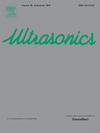Medical and biological applications of Langevin-type ultrasonic transducers: A narrative review
IF 4.1
2区 物理与天体物理
Q1 ACOUSTICS
引用次数: 0
Abstract
Power ultrasound is increasingly important in healthcare applications involving non-ionizing radiation. The evolution of piezoelectric-based transducers has enabled the expansion and cost reduction of high-power ultrasonic systems. Among these, Langevin-type transducers are prominent due to their low cost, versatility, and ability to generate high acoustic intensity, which significantly affects the propagation medium. Structurally simple, these devices consist of two metal masses compressing piezoelectric ceramics, secured by a tensioning bolt. For applications demanding high acoustic pressure, mechanical amplifiers can be coupled to intensify ultrasound output. Langevin transducers find extensive use in medical and biological fields. In medicine, they are applied in surgical tools, targeted drug delivery, and cellular stimulation, offering advantages such as cutting precision and tissue selectivity. In biology, they support enzyme activation, microbial control in food, and environmentally friendly biofuel production. Their capacity to enhance biological responses while minimizing invasiveness makes them valuable in both research and clinical contexts. This review explores the main applications of Langevin transducers in biomedical and biotechnological areas. It highlights their functional advantages, operational challenges, and future prospects. By consolidating current knowledge, this paper aims to clarify their role and potential in advancing health-related technologies and sustainable biotechnological solutions.

朗格万型超声换能器在医学和生物学上的应用综述
功率超声在涉及非电离辐射的医疗保健应用中越来越重要。压电换能器的发展使大功率超声系统的扩展和成本降低成为可能。其中,朗万型换能器因其低成本、通用性和产生高声强的能力而突出,这对传播介质有显著影响。这些装置结构简单,由两个压缩压电陶瓷的金属块组成,由一个张紧螺栓固定。对于要求高声压的应用,可以耦合机械放大器来增强超声波输出。朗格万传感器在医学和生物领域有着广泛的应用。在医学上,它们被应用于外科手术工具、靶向药物输送和细胞刺激,具有切割精度和组织选择性等优点。在生物学方面,它们支持酶活化、食品微生物控制和环境友好型生物燃料生产。它们在减少侵袭性的同时增强生物反应的能力使其在研究和临床环境中都很有价值。本文综述了朗格万传感器在生物医学和生物技术领域的主要应用。重点介绍了它们的功能优势、操作挑战和未来前景。通过巩固现有知识,本文旨在阐明它们在推进健康相关技术和可持续生物技术解决方案方面的作用和潜力。
本文章由计算机程序翻译,如有差异,请以英文原文为准。
求助全文
约1分钟内获得全文
求助全文
来源期刊

Ultrasonics
医学-核医学
CiteScore
7.60
自引率
19.00%
发文量
186
审稿时长
3.9 months
期刊介绍:
Ultrasonics is the only internationally established journal which covers the entire field of ultrasound research and technology and all its many applications. Ultrasonics contains a variety of sections to keep readers fully informed and up-to-date on the whole spectrum of research and development throughout the world. Ultrasonics publishes papers of exceptional quality and of relevance to both academia and industry. Manuscripts in which ultrasonics is a central issue and not simply an incidental tool or minor issue, are welcomed.
As well as top quality original research papers and review articles by world renowned experts, Ultrasonics also regularly features short communications, a calendar of forthcoming events and special issues dedicated to topical subjects.
 求助内容:
求助内容: 应助结果提醒方式:
应助结果提醒方式:


